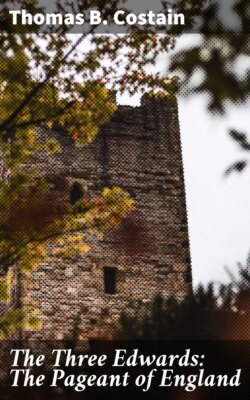Читать книгу The Three Edwards: The Pageant of England - Thomas B. Costain - Страница 17
На сайте Литреса книга снята с продажи.
3
ОглавлениеTable of Contents
The histories of three of the princesses, Eleanor, Joanna, and Margaret, seem to run in a pattern. In an age when marriages, particularly in royal families, were arranged when the principals were little more than infants, these three daughters of England’s greatest king seem to have found some belated happiness. When the queen died in 1290, Eleanor, as the oldest daughter, became the most important woman of her father’s court. Here, that same year, she was to find sympathy and solace in a Frenchman of great charm, the Duke of Bar-le-Duc, a new and well-considered friend of Edward. He became a constant visitor to the court and they, Eleanor and the duke, had the opportunity of close association. In her babyhood Eleanor had been affianced to the future King Alfonso of Aragon, but they never met and destiny gathered him to his royal fathers. Three years passed and Eleanor happily married the Duke of Bar-le-Duc.
In April 1290 the fiery-spirited, sloe-eyed Joanna of Acre married England’s most powerful peer, second to the king in importance, Gilbert de Clare, Earl of Gloucester. Joanna, too, had been given in betrothal at the age of five, to Prince Hartman, son of the king of the Romans. Edward seems to have arranged future marriages for his daughters with no idea of permitting their consummation but as perhaps a help toward some political expediency of the moment. Also, it is often plain that he could not part with his dearly loved daughters. Poor Prince Hartman went skating one winter’s day. The story is that he accidentally fell into open reaches where the water was deep, and drowned.
Gilbert de Clare was not young when he married Joanna and took her to live at his country retreat in Clerkenwell, not far from the Tower, where the king and queen were again in residence. She left for her new home with great fanfare, laden with royal gifts. Among them were forty golden cups, many more golden clasps, “twenty zones of silk, wrought and trapped with silver to give away to whom she pleased.” Hampers, coffers, baskets, and bags are listed without number. “One sumpter-horse carried her chapel apparatus, another her bed, a third her jewels, a fourth her chamber furniture, a fifth her candles! a sixth her pantry-stores and table linen, and a seventh her kitchen furniture.”
Joanna was but twenty-three when the old Earl of Gloucester died. After being a widow a year, she secretly married a completely unknown squire in her late husband’s retinue, Ralph de Monthermer. Through this marriage he became possessed in his own right of the earldoms of Gloucester and Hertford. The fact that a royal princess had dared to marry this obscure fellow became a cause célèbre which for a time separated her from the affection of her father. It proved to be a happy marriage, however, leading ultimately to a firm friendship between the new son-in-law and Edward.
Margaret, the fourth daughter of the king, married John of Brabant, an athletic young man, “stout, handsome, gracious and well-made,” whom she had known during her childhood. The colorful splendor of their wedding celebration—the extravagant costumes, the king and his knights attired in full armor—creates an unforgettable picture. All London seems to have joined the knights with their ladies in marching and singing through the streets of the city and suburbs while more than five hundred minstrels, fools, harpers, violinists, and trumpeters, some English, some foreign, cavorted about the palace grounds. Margaret was a merry child of fifteen years, the duke a few years older. Everything seemed conducive to a happy union. Actually the marriage proved disastrous. Margaret soon found that she was to be but one of many women in her husband’s life. In Brussels, where she eventually went to live, she was “doomed to the mortification of being perpetually surrounded with the bastard sons of her husband.”
Of the two remaining royal princesses, Elizabeth, Edward’s youngest daughter, married John, Count of Holland, a happy if uneventful union. Mary’s life at four had been prearranged by her parents. She became a nun, veiled at the convent of Ambresbury in 1284, where the queen dowager, Edward’s mother, Eleanor of Provence, had also taken the veil after the death of Henry III. Mary never forgot that she was a royal princess. She was seen everywhere and proved as much of a gadabout as her sisters. Life in the convent did not prohibit an active social existence outside, and she made demands regularly on the king for gifts of money and wine for her personal use. She died at fifty-four, the last survivor of the union of Edward and his first wife, Eleanor of Castile.
